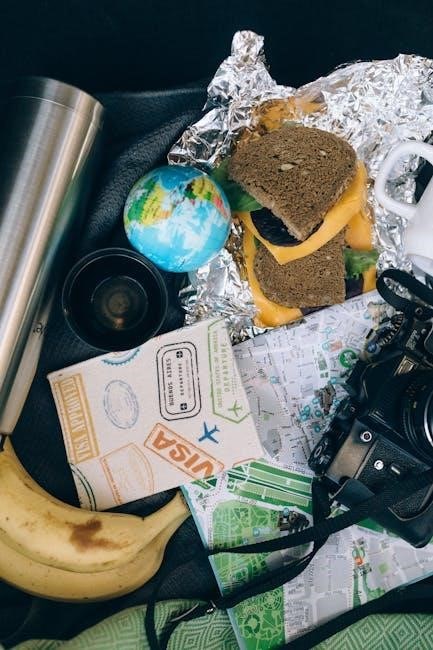Fermentation is the cornerstone of Noma’s culinary identity, transforming simple ingredients into extraordinary flavors. Every dish at Noma incorporates some form of fermentation, from bright vinegars to savory misos. This foundational technique, explored in depth in The Noma Guide to Fermentation, reveals the creative and scientific processes behind the restaurant’s innovative pantry of ferments.
The Role of Fermentation in Noma’s Culinary Philosophy
Fermentation is the heartbeat of Noma’s culinary philosophy, serving as both a creative and scientific foundation. It allows chefs to unlock hidden flavors, transform raw ingredients, and create depth in every dish. This process is not just a technique but a way to connect with nature and tradition, emphasizing the restaurant’s commitment to locality and innovation. Fermentation at Noma is a celebration of time and patience, where every ferment tells a story of its origins. By mastering this art, Noma has redefined modern cuisine, proving that fermentation is not just a method but a philosophy that elevates food to new dimensions. It is through fermentation that Noma continues to push boundaries, creating dishes that are both familiar and groundbreaking, ensuring its legacy as a pioneer in culinary excellence.
Meet the Authors: René Redzepi and David Zilber
René Redzepi, the visionary chef and co-owner of Noma, has revolutionized the culinary world with his innovative approach to local and seasonal ingredients. David Zilber, the mastermind behind Noma’s fermentation lab since 2016, brings a scientific precision to the art of fermentation. Together, they have co-authored The Noma Guide to Fermentation, sharing their expertise and groundbreaking techniques. Redzepi’s passion for foraging and Nordic cuisine pairs perfectly with Zilber’s technical knowledge, creating a comprehensive guide that demystifies fermentation. Their collaboration not only showcases the transformative power of fermentation but also highlights the importance of teamwork in culinary innovation. Through their work, they continue to inspire chefs and home cooks alike, proving that fermentation is both an art and a science.

Understanding the Science of Fermentation
Fermentation is a natural process where microorganisms like bacteria and fungi convert sugars into acids, gases, or alcohol. By controlling temperature, pH, and oxygen, chefs can steer this process to achieve desired flavors and textures, creating everything from tangy vinegars to umami-rich misos.
The Basics of Lacto-Fermentation

Lacto-fermentation is a foundational technique at Noma, relying on lactic acid bacteria naturally present on vegetables. This process creates a tangy, umami-rich flavor while preserving food. By submerging vegetables in a brine or their own juice, an anaerobic environment is established, fostering the growth of beneficial bacteria. Temperature control is crucial, with optimal fermentation occurring between 64°F and 75°F. Over time, the bacteria convert sugars into lactic acid, lowering pH and inhibiting pathogens. The result is a crunchy, vibrant ferment with enhanced texture and flavor. Noma’s approach emphasizes simplicity, using salt, water, and time to unlock the full potential of ingredients. This technique is central to their pantry, offering endless possibilities for creativity in the kitchen.

Exploring Koji and Its Transformative Power
Koji, a fungus known as Aspergillus oryzae, is a cornerstone in Noma’s fermentation practices, renowned for its ability to break down proteins and carbohydrates. This natural catalyst creates profound flavor transformations, enhancing umami and tenderizing ingredients. At Noma, koji is harnessed to innovate dishes, blending traditional techniques with Nordic cuisine. The enzymes in koji convert starches into sugars and proteins into amino acids, yielding complex, savory flavors. Its role is pivotal in crafting miso, shoyu, and other ferments, each showcasing its versatility. Koji’s impact extends beyond flavor; it revolutionizes texture, making it an indispensable tool in Noma’s culinary arsenal. This fungus exemplifies the transformative potential of fermentation, driving creativity and innovation in the kitchen.
Essential Fermentation Techniques
Noma’s fermentation techniques emphasize precision and patience, from lacto-fermentation to koji’s enzymatic power. These methods unlock deep, complex flavors, forming the backbone of the restaurant’s innovative culinary approach.
Step-by-Step Guide to Creating Fermented Vegetables
The Noma Guide to Fermentation offers a detailed, step-by-step approach to fermenting vegetables, transforming them into vibrant, flavorful ingredients. The process begins with selecting fresh, seasonal produce and creating a saltwater brine to inhibit harmful bacteria. Vegetables are submerged in an anaerobic environment, allowing natural lactic acid bacteria to thrive. Over days or weeks, the fermentation progresses, developing tangy, umami-rich flavors. The guide emphasizes the importance of monitoring temperature, texture, and acidity to ensure optimal results. With precise instructions and over 500 photographs, the techniques are accessible to both home cooks and professionals. The guide also explores advanced methods, such as fermenting at controlled temperatures, to enhance complexity. By mastering these techniques, readers can create a wide variety of fermented vegetables, from classic sauerkraut to innovative, Noma-inspired recipes.
Mastering the Art of Making Miso and Shoyu
Making miso and shoyu is a cornerstone of Noma’s fermentation expertise, blending traditional techniques with Nordic innovation. Miso, a fermented soybean paste, is crafted by combining koji-spawned grains with beans, then aging for months to develop its rich, savory depth. Shoyu, a fermented soybean sauce, follows a similar process but includes roasted grains and a longer fermentation period. The Noma Guide to Fermentation details these processes, offering precise step-by-step instructions and photographs to guide readers. The authors emphasize the importance of quality ingredients and patience, as the slow transformation yields complex umami flavors. By mastering these techniques, home cooks and professionals alike can create authentic, deeply flavorful miso and shoyu, essential for enhancing a wide range of dishes with their distinctive, aromatic profiles.

Advanced Fermentation Methods
Explore the transformative power of kombuchas, vinegars, garums, and black fruits. These advanced techniques push fermentation boundaries, offering bold, complex flavors to elevate any dish, guided by Noma’s expert insights and visuals.
Working with Kombuchas and Vinegars
Kombuchas and vinegars are powerful tools in Noma’s fermentation arsenal, adding bright, tangy dimensions to dishes. Kombucha, made from a symbiotic culture of bacteria and yeast, is often used to infuse sauces or dressings with vibrant acidity. Vinegars, crafted through secondary fermentation, offer concentrated flavor profiles. At Noma, these techniques are refined to balance boldness and nuance, enhancing the overall culinary experience. The Noma Guide to Fermentation provides detailed insights into these processes, ensuring home cooks and professionals alike can master these transformative methods with precision and creativity. With step-by-step instructions and stunning visuals, the guide demystifies the art of working with kombuchas and vinegars, inviting readers to experiment and innovate in their own kitchens.
Crafting Garums and Black Fruits
Garums and black fruits are two of Noma’s most innovative fermentation creations. Garum, a fish-based condiment, is crafted through precise fermentation, often using mackerel or squid, aged for months to develop its deep, umami flavor. This process, detailed in The Noma Guide to Fermentation, results in a liquid gold that enhances sauces and dressings. Black fruits, such as fermented blackberries or elderberries, are transformed into intense, tangy preserves. These fruits are preserved through lactic or acetic fermentation, creating bold, complex flavors. At Noma, they are used as condiments or integrated into desserts. The guide provides meticulous recipes and techniques for replicating these unique elements, offering readers a gateway to experiment with garums and black fruits in their own kitchens. These methods showcase Noma’s commitment to pushing culinary boundaries while maintaining a deep respect for fermentation’s transformative power.





